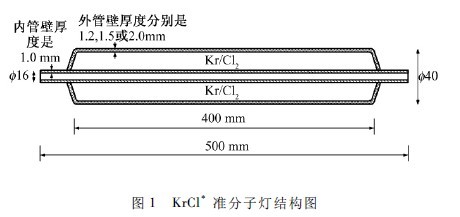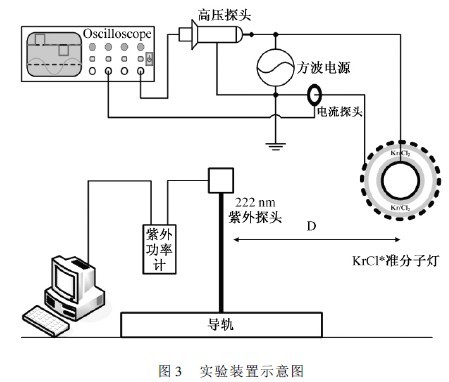1 Introduction
An excimer is a diatomic molecule in an excited state (excited dimmer, abbreviated as excimer), and there is no stable ground state. Usually, excimers exist on the order of nanoseconds, and then spontaneously radiate back to a state where energy is less, and then photons are radiated and decomposed into atoms.
Excimers generally include rare gases (Rg*2) [1 to 6], halogens (X*2) [4 to 7], rare gases-halogen (RgX*) [3 to 6, 8 to 13], and mercury-halogen. (HgX*)[6,12,14] Dimers whose spectra are narrow-band radiation in the ultraviolet (UV) and vacuum ultraviolet (VUV) regions. The wavelengths of halogen molecules F*2, Cl*2, Br*2 and I*2 are 158, 259, 289, 342 nm, respectively; rare gas excimer He*2, Ne*2, Ar*2, Kr*2, Xe The wavelengths of *2 are 74, 84, 126, 146, and 172 nm, respectively. The wavelengths of the rare gas-halogen excimer are shown in Table 1.

The use of excimer light sources can be divided into two categories. The first type is lighting use, that is, the excimer light source can be made into a mercury-free light source that is environmentally friendly, such as Xe*2 (172 nm) as a planar illumination source; and the other is a non-illumination application, that is, an ultraviolet light source. Compared with the mercury atomic spectrum of a conventional low-pressure mercury lamp, the excimer emits narrow-band radiation at a large power density because there is no stable ground state and there is no self-absorption of the ground state.
Excimer ultraviolet light sources can be discharged in a variety of forms, including high-pressure glow discharge, dielectric barrier discharge, high-frequency capacitor discharge, microwave discharge, and hollow cathode discharge, all of which can effectively excite excimer light. Among them, dielectric barrier discharge (DBD) is widely used in research and application due to its simple structure, economical and practical. The DBD-driven excimer lamp has no internal electrodes, which avoids corrosion and sputtering after the electrode is in contact with the plasma. It is a potential long-life UV source and can be changed in shape and size according to various needs.
Most photochemical and photophysical applications require strong radiation in specific wavelength regions. For example, 254 nm radiation from a low-pressure mercury lamp is suitable for most applications, but this wavelength is completely ineffective for removing chlorate compounds [15] because it does not match the absorption peak of the chloroester compound at 210 to 230 nm. The 222nm narrow-band radiation of KrCl* excimer lamps is highly efficiently absorbed by chlorocarbons and can be used for photo-oxidation of tetrachloroethylene, trichloroethylene, dichloroethylene, vinyl chloride and some saturated chlorinated hydrocarbons [16]. Proven to be of great use in water treatment and air purification [17,18].
KrCl* excimer lamps are mostly DBD drives with coaxial structure, but the pipe diameter, optimal aeration conditions and power supply are different. Some research groups have given the efficiency of KrCl* excimer lamps [8-11]. Zhang et al. [8] reported that KrCl* excimer lamps can achieve a maximum efficiency of 15% under RF drive (voltages of 3.5 to 10 kV, frequency of 125 to 375 kHz, chlorine pressure of 15 Torr, and total pressure of 225 Torr). However, in the literature [9-11], the optimum efficiency is 10% to 15%, and the optimum inflation pressure is 200 Torr (Kr: Cl2 = 200: (1 - 0.5)), 150 to 200 Torr (Kr: Cl2 = 100: 1) and 500 Torr (Kr: Cl2 = 50: 1). It is worth noting that the literature [8,9] reported the use of water cooling to achieve higher efficiency.
Since it is difficult to accurately measure the radiant power at 222 nm, the optimal parameters and optimal efficiencies of the various research groups vary widely [18]. In the literature [8], the absolute radiant intensity of 222 nm is measured by chemical method using uridine; while in the literature [9-11], the 222 nm radiation is measured by the calibrated FEK-22 SPU photodiode with an oscilloscope. power. In this paper, a method for measuring the efficiency of KrCl* excimer lamps is proposed, that is, the ultraviolet irradiance is measured, and the radiant power is calculated by the Keitz formula [19]. The Keith formula has been recommended by the International Ultraviolet Association (IMA) for the measurement of 254 nm radiant power in low-pressure mercury lamps [20]. This experiment was first used to measure the radiant power of a 222 nm KrCl* excimer lamp.
2 experiment
2. Preparation of 1 KrCl* excimer lamp The cesium chloride quasi-molecular lamp is a coaxial double-layer quartz sleeve. The structure diagram is shown in Figure 1. The outer diameter of the outer quartz tube is 40mm and the wall thickness is 1. 2,1. 5,2. 0mm, tube length 400mm; inner and outer quartz tube inner and outer diameters are respectively 14 / 16mm, wall thickness is 1. 0mm, tube length is 500mm. The inner and outer diameters of the cylinders are 37 / 40, the 36 / 40 and 14 / 16mm quartz tubes are GE214 quartz, and the inner and outer diameters of 37.6 / 40mm quartz tubes are Heraeus quartz. The transmittance of the three kinds of wall thickness of the quartz glass at 190 to 350 nm is as shown in Fig. 2, and the transmittance at 222 nm (the dotted line in the figure) is 85.0%, 81.3% and 67.6%, respectively. . The outer electrode is a stainless steel mesh and the inner electrode is a stainless steel sheet. The annular gap of the quartz sleeve is 10.8.10. and 10.0mm, which is filled with high purity chlorine gas and helium gas.



2. 2 Experimental devices and measurement methods
The experimental setup is shown in Figure 3. The excimer lamp is placed horizontally on two Teflon holders and is driven by a square wave power supply (frequency adjustable from 40 to 70 kHz). Use a high voltage probe (Tektronix P6015A) and a current probe (Pearson P4100) with a digital storage oscilloscope ( Nicolet Sigma 60) to measure the voltage and current waveforms of the excimer lamp. Ultraviolet irradiance probes (Haramatsu H8025-222) and UV irradiance meters (Haramatsu C8026) were used to measure irradiance at 222 nm. The probe can move along the rail. To minimize reflected light, all reflective surfaces around the probe are covered with a black velvet cloth that absorbs light. The wires of the power supply are as short as possible to reduce the loss of input power.
(1) Input power
The input power Pin of the excimer lamp is directly integrated by the instantaneous power (that is, the product of the instantaneous value of the voltage and current).

Where u is the instantaneous voltage, i is the instantaneous current, T is the period, N is the number of samples in the period, and Δt is the sampling interval. When the voltage and current waveforms are stored to the oscilloscope, the input power can be calculated from equation (1). In order to improve the accuracy of the calculation, at least two cycles of data are sampled.
(2) Radiated power
Because the diameter of the excimer lamp is much smaller than its length, it can be regarded as a line source, radiant power of 222nm Prad
Can be calculated by the Keitz formula [19,20],

Where E is the measured irradiance (W·m - 2 ), D is the distance from the center of the lamp to the UV probe (m), L is the length of the lamp (m), and α is the half apex angle, as shown in Figure 4. Shown as tgα = L / (2D).

The 222 nm irradiance was measured by an ultraviolet irradiance meter perpendicular to the KrCl* excimer lamp. Because D ≥ 2L, the UV probe satisfies the law of cosine [20]. The irradiance meter has a sampling frequency of 1 / s and samples at least 120.
(3) UV efficiency
According to the ultraviolet radiation power Prad and the input power Pin calculated above, we can obtain the radiation efficiency of 222 nm according to the formula (3).

According to this, the optimal parameters of the excimer lamp, such as total pressure, chlorine partial pressure, wall thickness, discharge gap, input power, etc., can be found.
